
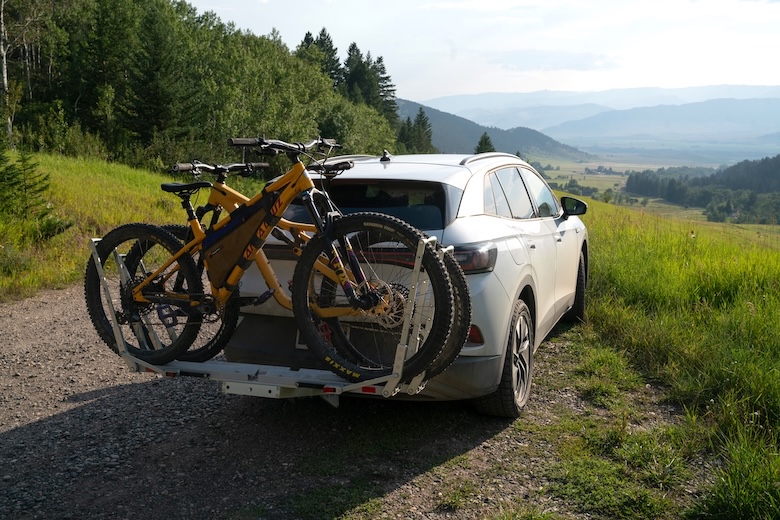
Price: $600
Number of bikes: 1 (up to 4 with add-ons)
Weight: 37 lb.
Weight capacity per bike: 100 lb. (for first 2 bikes)
What we like: Gorgeous yet hardwearing design; extremely versatile and customizable.
What we don’t: Expensive; base package is not as extensive as other racks; does not work well if your bike has a rear fender.
See the 1Up USA Super Duty
1Up UPA, based in the Midwest mountain bike mecca of Wisconsin, has long been a leader in making beautiful, hardwearing bike racks. The newest version of their rugged Super Duty, released in April of 2024, is the result of years of perfecting their unique design. The overhaul of the Super Duty model, which maintains its signature simplicity, allows loading your bike with only one hand, the ability to adjust the wheelbase, and an increased weight capacity. I tested the “single” model of the Super Duty, with an additional one-bike add-on (a $270 extra purchase for the silver model), putting the rack through its paces on long highway trips, crawling along rutted dirt roads, and hucking over terrifyingly large potholes to get our bikes to trailheads in the northern Rockies. All in all, the rack proved to highly competent, versatile, and durable. Below are my thoughts on the Super Duty. To see how it measures up to the competition, check out our article on the best hitch bike racks.
1Up USA has developed a loyal following in parts of the mountain bike community. Putting their newly improved Super Duty through its paces, it’s easy to see why: Their bike racks are simple, beautiful, easy to use, and durable. After hundreds of miles blasting down 80-mile-per-hour freeways and crawling up steep and rutted dirt roads, I'm left with little to complain about on the Super Duty. All of 1Up’s racks—the Super Duty included—stem from their chief innovation: a simple design featuring two levers that contact only the rubber of your tires. How it works: Open up the levers, lift your bike onto the rack, and close the levers. Just like that, you’re good to hit the road. The build is all-metal, designed to last, and rated for off-road use. Plus, the trays are pitched upward from the car, allowing more clearance for obstacles on the road and more handlebar/seatpost clearance as you add bikes. This is a purely subjective observation, but I also think 1Up’s designs are the most aesthetically appealing on the market (as well as the most hardwearing).
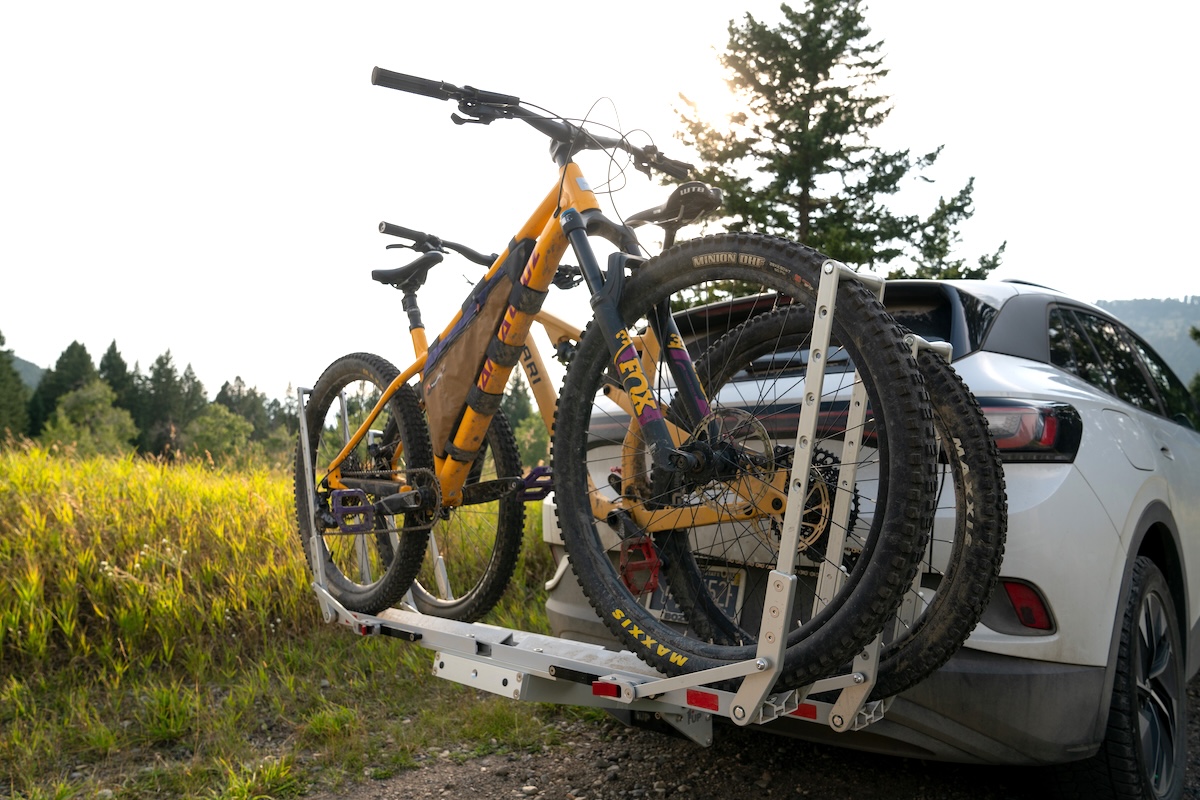
1Up’s expanding ball bearing in the hitch creates a stable seal attaching the bike to the car, even when jostling the bike for miles over rough roads. And after months of constant use, my Super Duty had little wear to show for the miles. I only have two nitpicky complaints when it comes to performance. First, while the Super Duty features ample adjustability to fold the rack up for storage or down to make room to open your trunk, reaching the tilt lever can be a bit tricky when the rack is loaded with two or more bikes (though 1Up does offer a tilt lever extender for an additional $99). Second is security: The rack comes with a lock to keep it attached to your hitch, but it doesn’t include an integrated bike lock, which comes stock with many other offerings on the market, like Thule’s T2 Pro XTR and Kuat’s NV 2.0. That said, most riders do have their own bike locks that can work just fine in a pinch. 1Up also offers simple but effective wheel locks of their own for $24.
The 1Up USA Super Duty comes boxed up in just a few pieces per bike tray. Putting it together involves about 10 minutes—or less—and a few turns of an included Allen wrench. When you slot the rack into your hitch (this rack is compatible with either 2- or 2.5-in. receivers), the very same wrench twists the anti-wobble ball bearing into place, securing the rack in its mount. Then, all you need to do is load up. And when it comes to loading bikes, few racks are easier to operate. Levers on the rack allow you to open the two sliding arms with one hand (you used to have to pull the lever with one hand and open the arm with the other). Once the arms are open, lift the bike onto the rack. Then, push the arms closed over the tires of the bike, and you’re ready to go. All told, loading a bike takes less than 30 seconds at a leisurely pace.
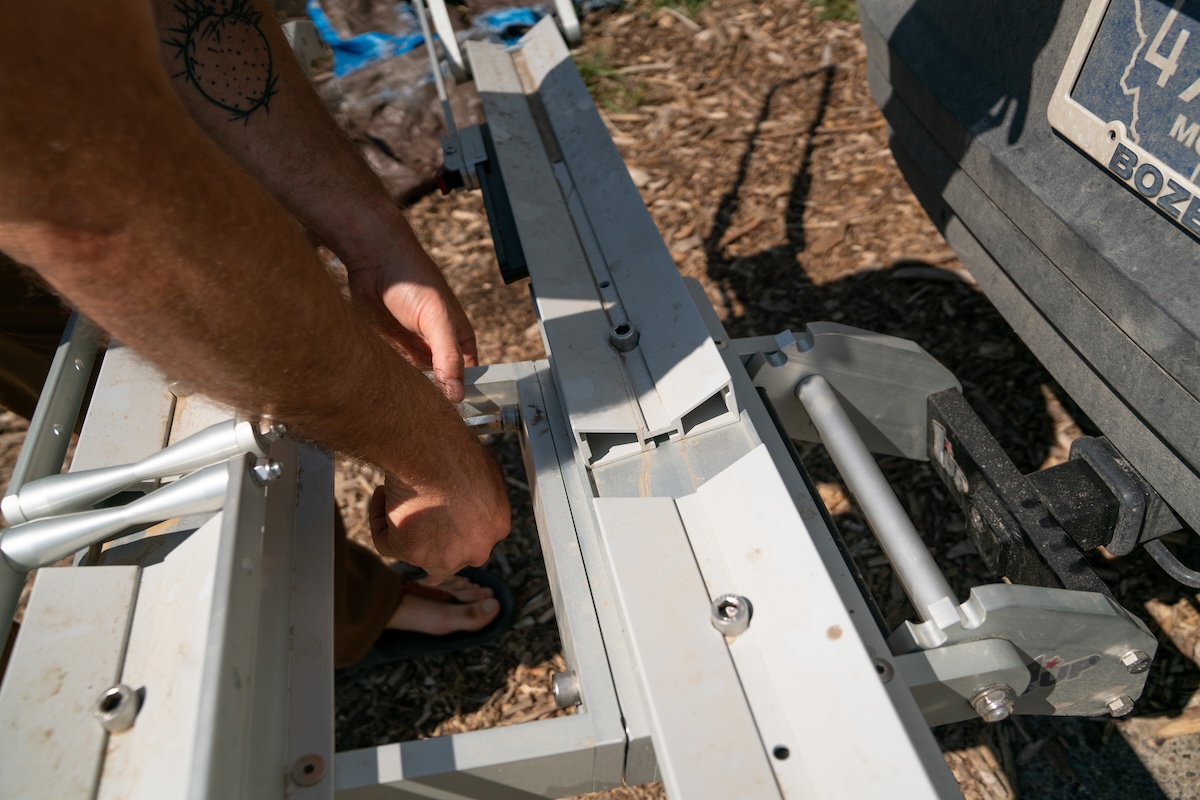
Unloading is just as easy: Simply push the arm against the tire of your bike a bit while pressing down the switch, and voila, it’s ready to unload. In practice, I found that sometimes it took a bit of muscle to get the lever to disengage. But that’s likely a result of user error—pushing the arm too close to the tire to begin with. And even this was a very small issue. Converting the Super Duty into a two-bike setup is as simple as putting together the second tray (essentially the same process as the first one). Then, partially screw in two provided machine screws into the rear of that first bike carriage. Insert the second bike addition, push the rack over, tighten those screws, and you’re all set. (I found this process is easiest when the one-bike setup is already mounted on your car.) As a whole, setting up and removing the rack is simple and easy and requires just one Allen wrench for everything. To make sure I don’t lose that wrench, I keep it in the glove box of my car.
Bike capacity and wheel size versatility are two areas where the Super Duty truly shines. Out of the box, this rack blows most others out of the water. It fits bikes with 16- to 29-inch wheels and is compatible with tires up to 5 inches wide. In short, it’ll fit your roadie, your mountain bike, or your fat bike just fine. The new version of the Super Duty also features adjustable trays that extend to fit wheelbases up to 58 inches (the inner position fits 54-in. wheelbases), and the trays can even be offset for added adjustability. 1Up also increased spacing between the trays, allowing for extra room that can better accommodate wide downtubes or flat pedals. In practice, I had no issues loading two beefy mountain bikes with flat pedals on the rack with plenty of room to spare. For driving the most rugged of roads, or for hauling particularly heavy e-bikes weighing 75 pounds or more, 1Up also offers a wheel chock to help stabilize things for an extra $110. In practice, I didn’t find the wheel chock necessary for ordinary mountain bikes, even when cruising over ruts and potholes in remote corners of Montana.
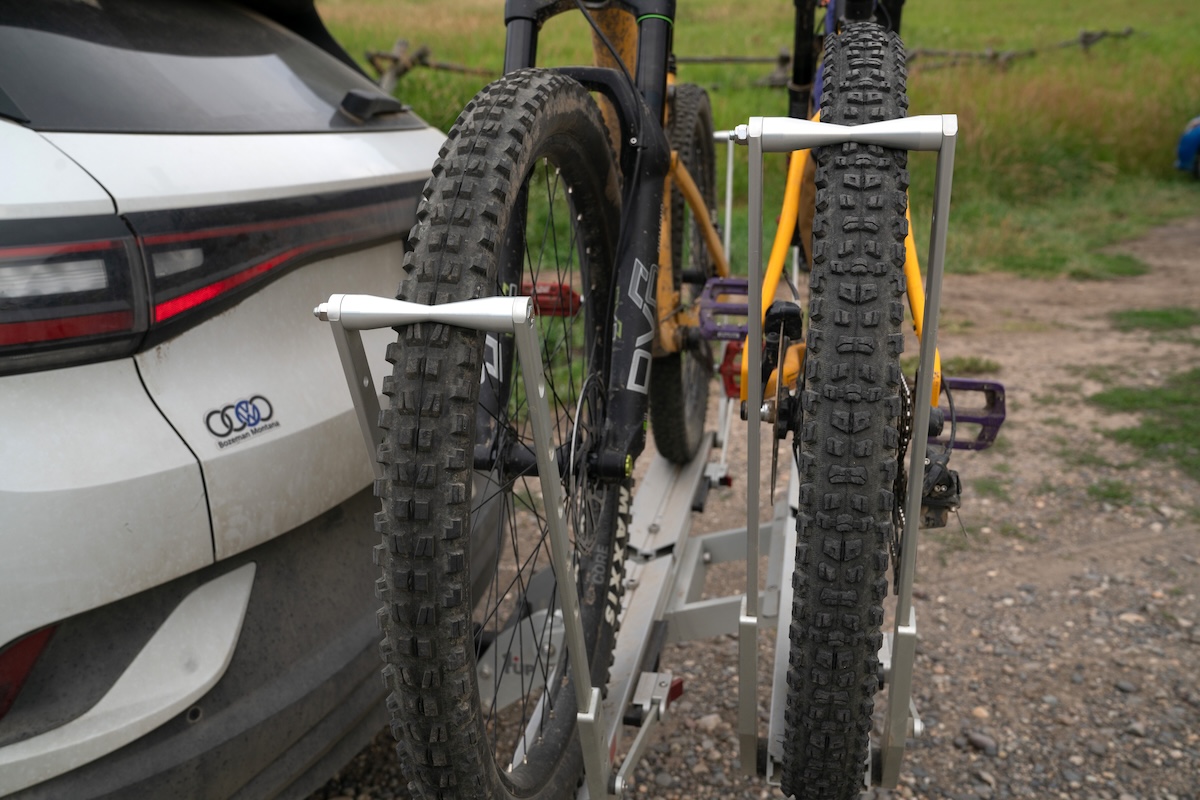
The updated version of the Super Duty features a massively improved weight limit of100 pounds per bike, up from 75 in the previous model. Effectively, this is just about the burliest rack out there (in our searches, only 1Up’s own Xtreme Duty—meant for e-motos—can top it). For reference, your average mountain bike will range from the high 20s to low 30s in poundage, so the Super Duty might be overkill if that’s all you’re hauling. But the battery in e-bikes adds a massive amount of weight. Most eMTBs weigh around 50 pounds, and commuter e-bikes can weigh even more. Aventon’s newest Aventure 3, for example, checks in at 76 pounds. So while this added capacity isn’t necessary for everybody, it opens up a world of ease for lots of e-bikers and provides extra peace of mind for any load. If you do have an ultra-heavy bike, 1Up also sells a ramp that starts at $122 that can help you get things loaded (as loading and unloading a heavy e-bike alone can be quite difficult).

This is yet another area where the 1Up USA Super Duty truly knocks it out of the park. The all-aluminum construction is utterly bombproof. We’ve used past-generation models for years with little wear and tear and no need for replacement parts after constant abuse. The newest version of the Super Duty is no different. This rack is burly and built to last. It's also rated for what 1Up calls “extreme off-road” use, their highest rating of any rack in their lineup. In practice, the rack gave me no issues when taking it on roads nearing that “extreme” condition. Even on a mid-clearance SUV, the rack rests high enough off the ground to avoid bottoming out. Rocking back and forth over rocks, washboard, and potholes, I didn’t notice any loosening on the hitch or noticeable wobble. After months of abuse, the Super Duty looked as good as new after a simple spray-down with a hose. For me, the vehicle was much more limiting for terrain than the rack. So while the Super Duty is quite expensive—especially with all the add-ons—it just might be all the rack you ever need.
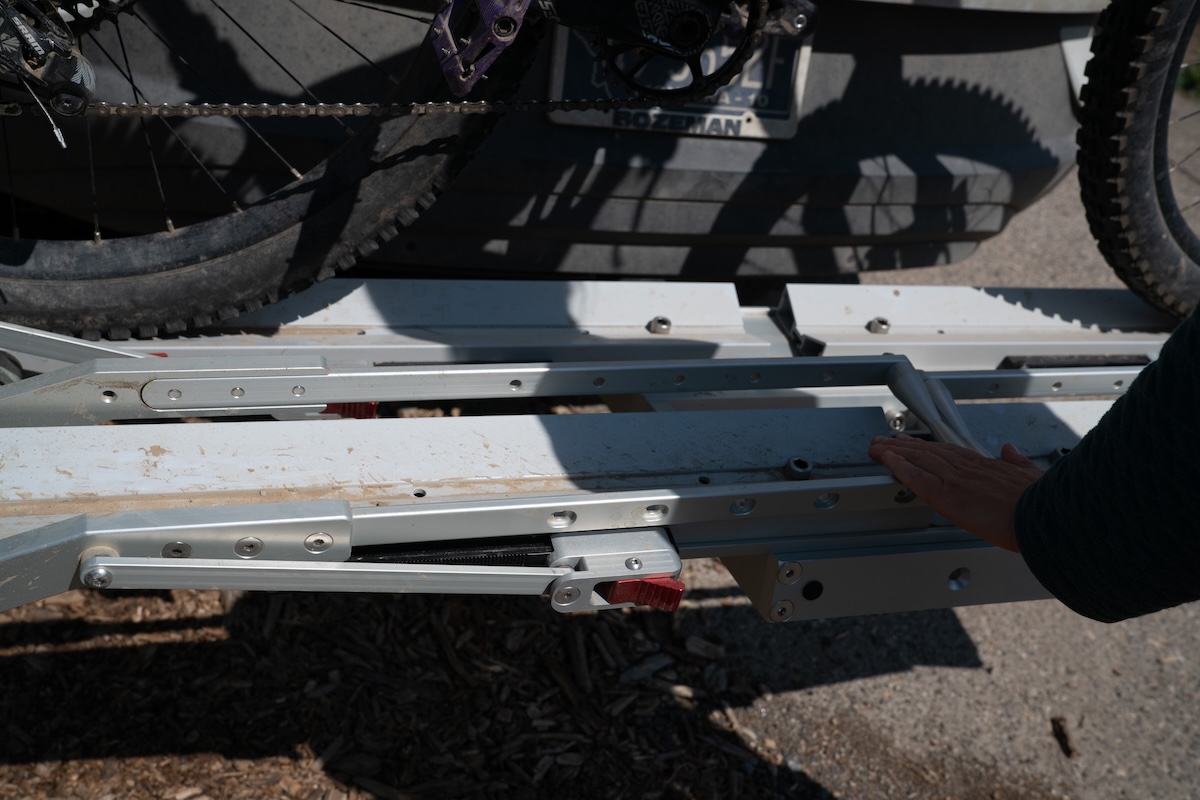
The one-bike version of the 1Up Super Duty is perfectly manageable at 37 pounds. I find this version is light enough to easily swap on and off the car when I get home, but it’s a great fixture to stay on the vehicle, too. That said, the weight quickly adds up when you convert the rack to its higher-capacity versions. The double version of the Super Duty weighs in at 64 pounds, which is 12 pounds heavier than a comparable double rack like Thule’s T2 Pro XTR. That bulky weight is a product of the Super Duty’s all-aluminum build and hefty weight capacity, and, in theory, pays off in both longevity and durability. And it’s still an entirely manageable weight in practice. I dealt with the rack mostly in two parts: the one-bike platform and the add-on. Taking the two pieces apart takes less than a minute and cuts your weight in half. And if the weight still proves too much, or you don’t have a need for 5-inch tires and a 100-pound capacity, it’s worth looking into 1Up’s Heavy Duty Double, which clocks in at a lighter 47 pounds (or just 28 lb. for the single version).
1Up’s unique two-lever system is, in my opinion, the simplest and most durable on the market. It features two identical arms that open and close, securing over the front and rear tires of your bike. The arms only make contact with the rubber of your tires, keeping the attachment low-impact and effective, even when driving at high speeds or over gnarly terrain. With changes in 1Up’s patent, you can find copycat racks of various quality out there, too. But the 1Up is the original, and the prevalence of the design is a testament to its effectiveness.
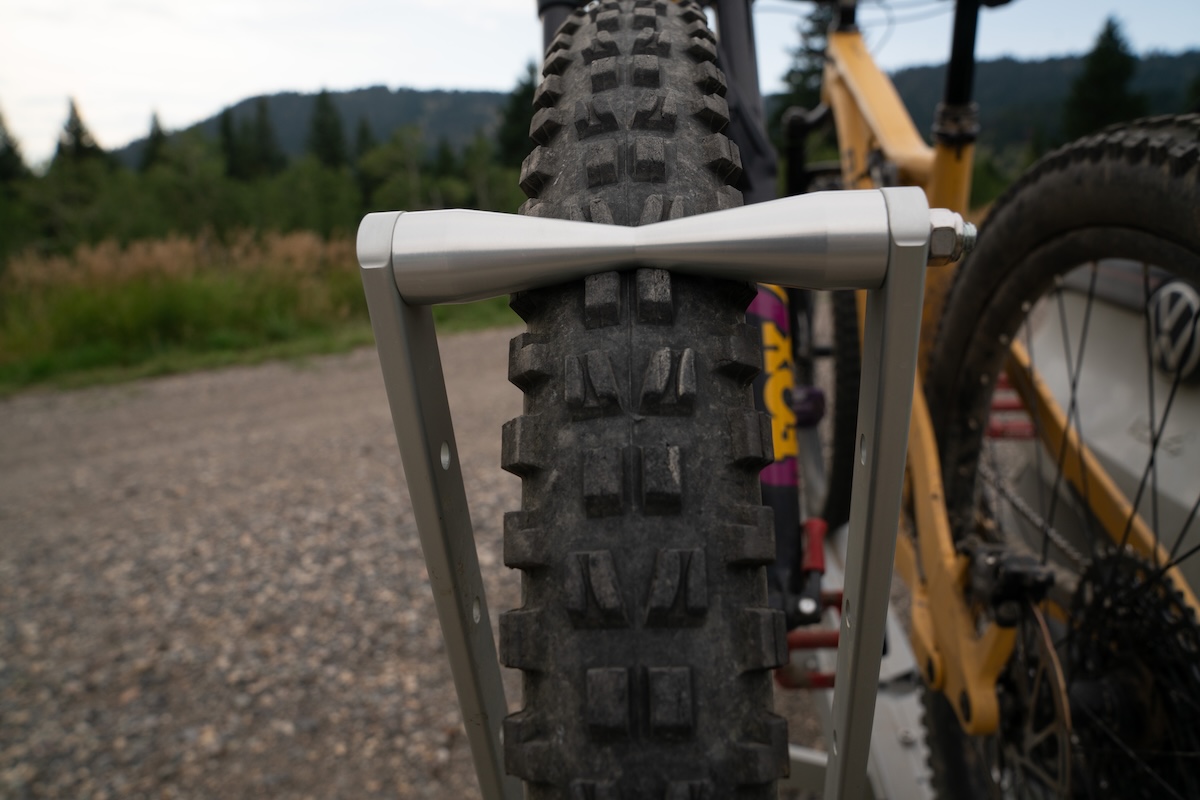
The Super Duty is arguably the most versatile bike rack on the market. It can accommodate only one bike if that’s all you need, or it can be customized for as many as three (and up to four for the Double version). With its sky-high weight capacity and compatibility with a range of tire sizes, you can haul whatever you need, from a featherweight racing rig to an ultra-heavy e-bike (or both). The Super Duty also features one-handed loading capability and, as mentioned above, adjustable racks to accommodate longer wheelbases and wider setups. Add-on customizations are a strong suit of the rack, too. Don’t have the budget for the $900 two-bike rack? No problem—start a little smaller with the $600 single and purchase the add-on ($270-300) down the road when you have the cash.
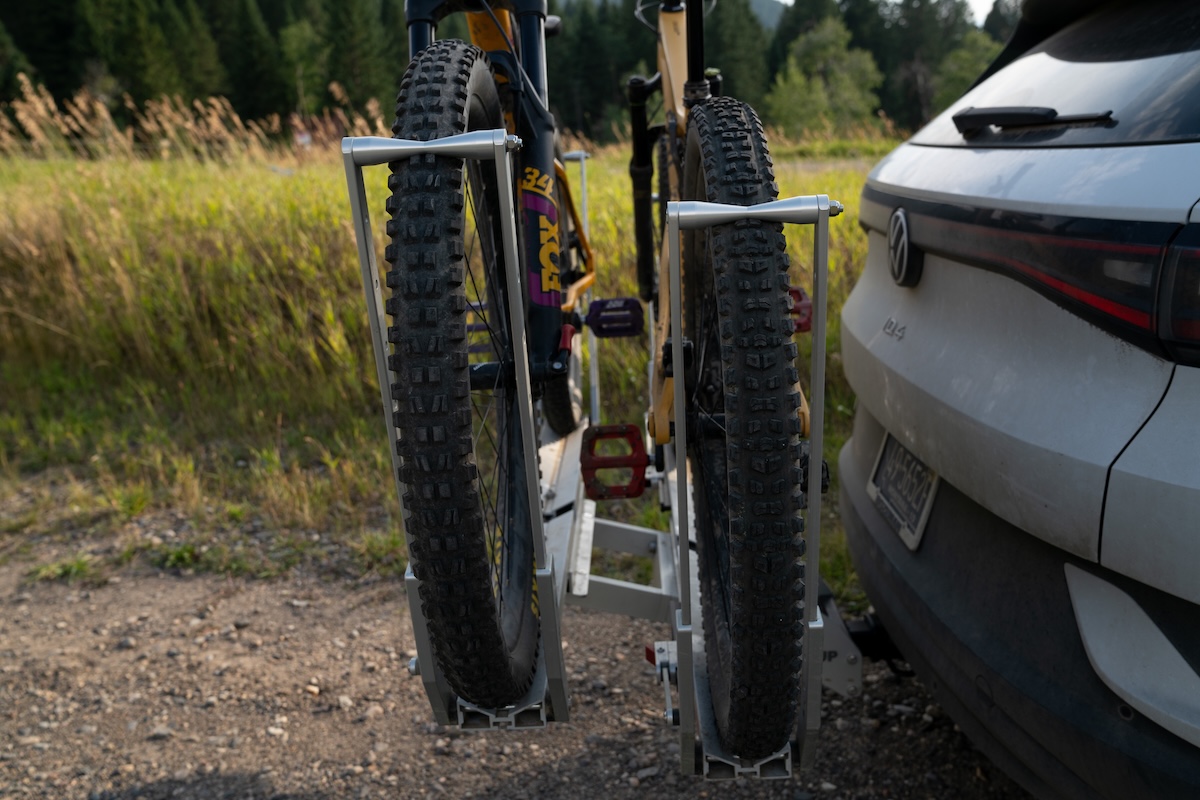
1Up also offers a suite of extras that can make your life easier: For an extra cost, you can get bike wheel locks, a tilt lever extender, a ramp, a wheel chock, and even an LED bar with a license plate holder. These are great options for the user looking to kit out their rack. But for the biker on a budget? Not so much. Getting a fully outfitted Super Duty Double with all the above goodies would put you back close to $1,500 all in. In our minds, this is the main downside of the rack: It’s expensive.
A bike rack is first and foremost for hauling. But making sure you can store the rack when you’re not using it and access your trunk even when it’s loaded up is important for functionality, too. The 1Up’s tilt lever allows the rack to fold 90 degrees upward for storage or to be folded downward for rear cargo access. The lever itself is fully functional, but it’s also beefy and sturdy, which can make for some amount of difficulty activating. This is partially due to the overall design, meant to prevent unnecessary wobble. The tilt lever is also a bit hard to access with two or more bikes loaded up if you don't have the EZ Pull add-on, which comes with an added cost of $99. In short, there are more easily workable tilt levers out there, but the 1Up’s gets the job done and keeps the system from moving around too much.
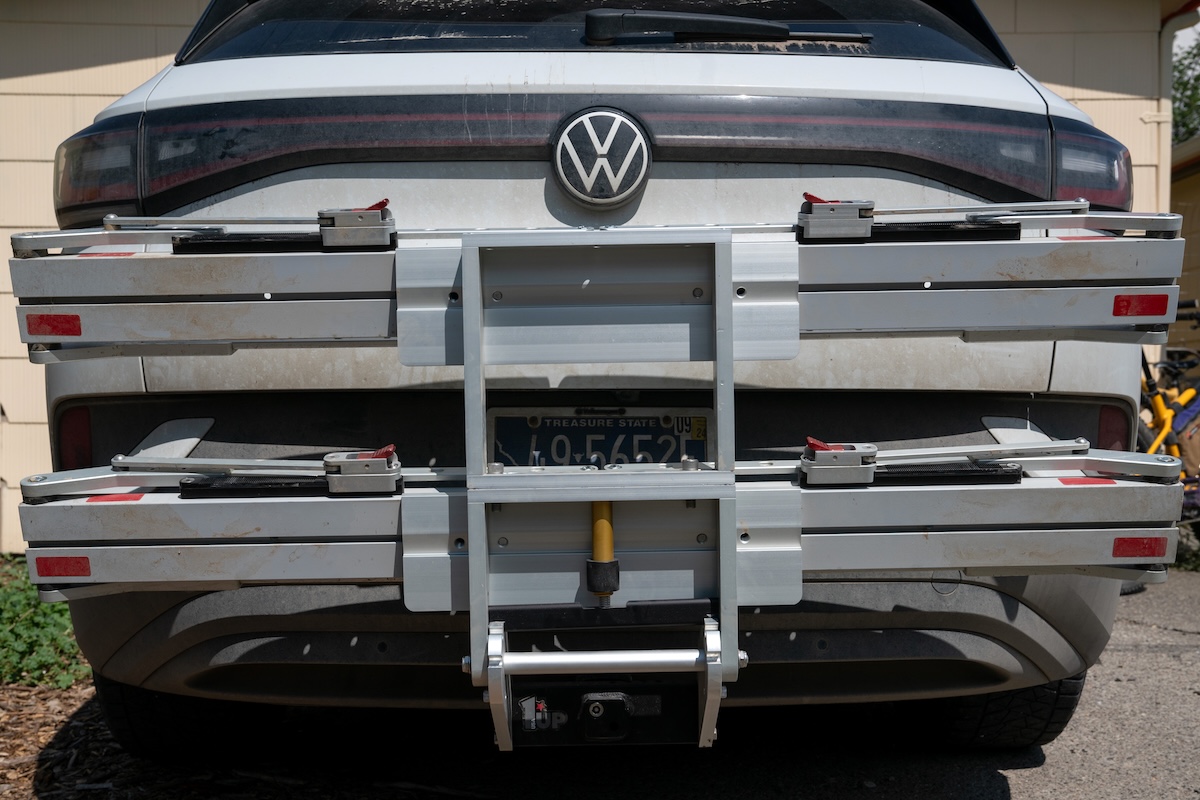
Lots of bike racks feature some metal and a hefty injection of plastic. These are great in the short term but tend to suffer down the road as rain, cold, heat, dirt, sand, and general use and abuse take their toll. The Super Duty’s all-aluminum build means it’s built to last and to endure the gnarliest of conditions. After years of using 1Up racks, our team has yet to have any problems with longevity. The Super Duty is also designed for “extreme off-road” use. We’ve put this rack through the wringer, and it seems to live up to that claim. In short, 1Up’s design is a simple system that's built to last. Despite the added cost compared to some of the alternatives, many users argue that you can save money in the long run thanks to the rack’s sheer longevity.
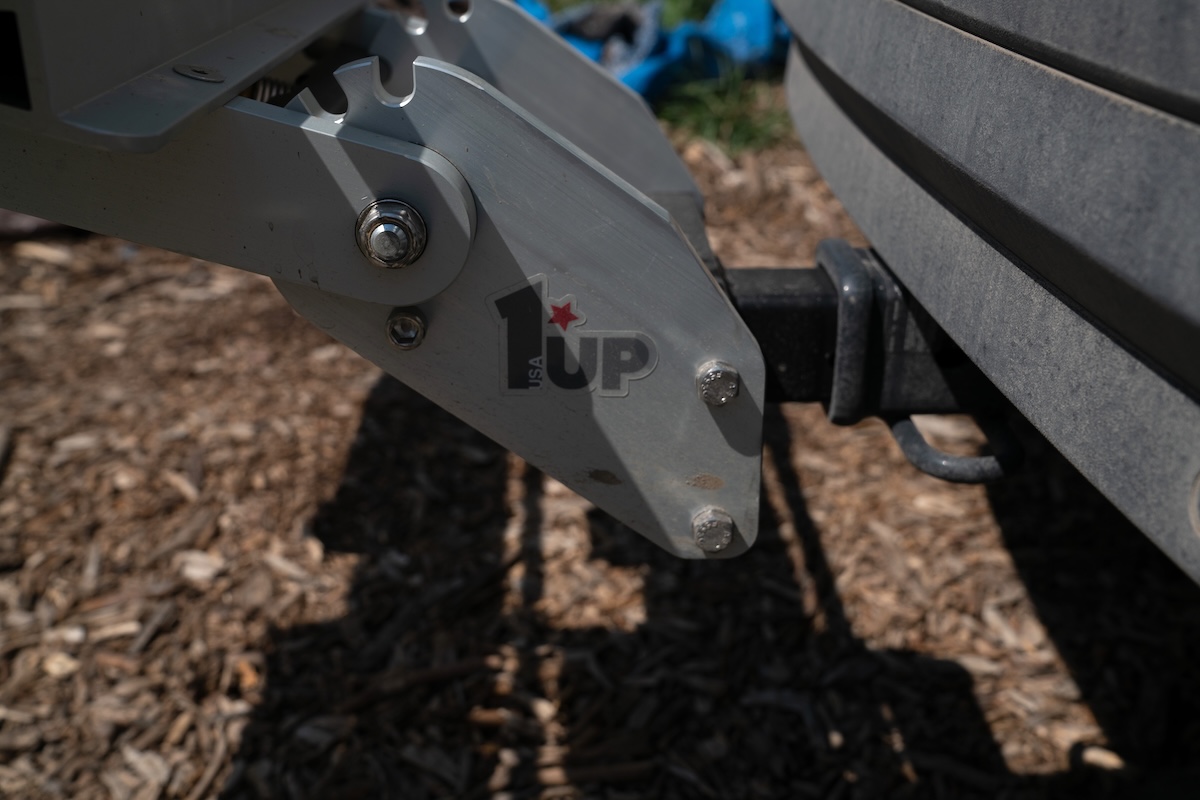
I tested the one-bike version of the Super Duty in the silver color with a 2-inch hitch receiver, and I later added the Quik Rack to be able to accommodate a second bike (this cost $870 in total). The Super Duty is also available in a two-bike version for $900 for the silver model (the black version is $950), and both versions can also be ordered with a 2.5-inch hitch receiver meant for 3/4-ton trucks and larger vehicles. The Quik Rack Add-On will run you $270 per additional bike for the silver version or $300 for the black color. You can add up to two additional bikes to your base model, meaning the single Super Duty can be optimized for three bikes and the double for up to four.
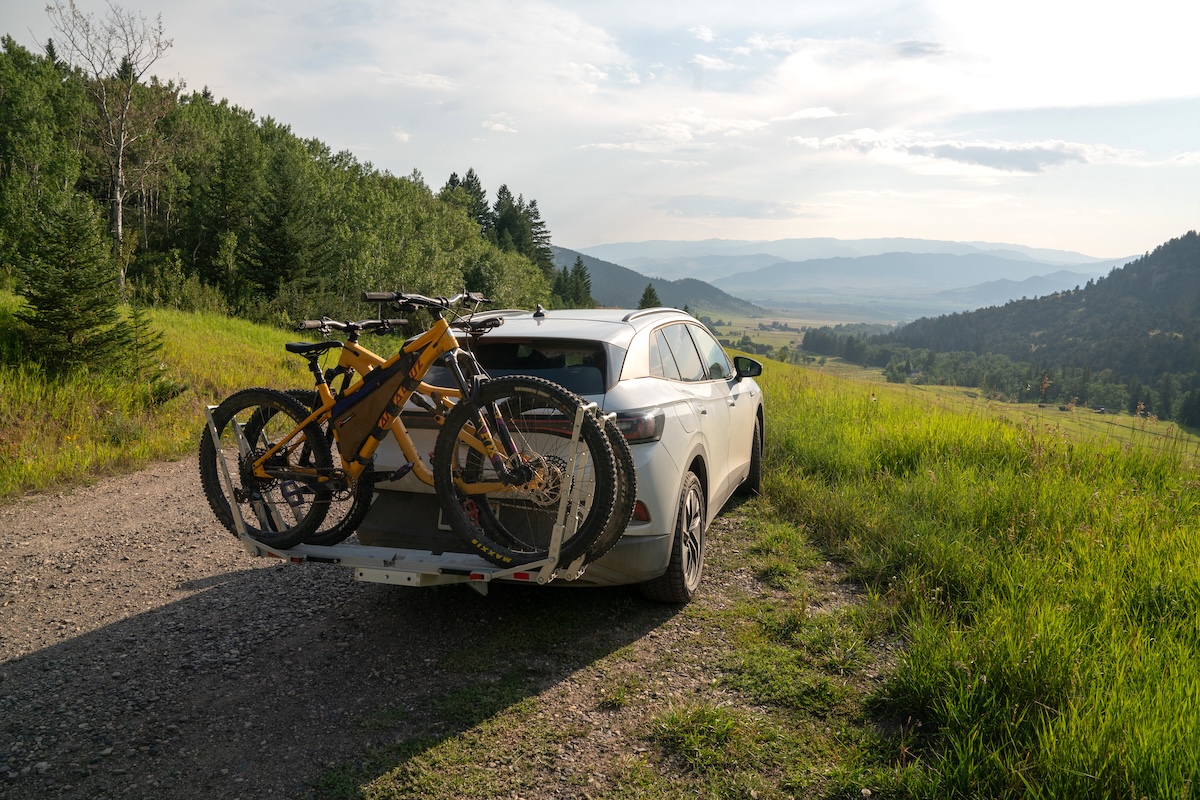
| Rack | Price | Weight | Tire Width | Wheel Sizes | Capacity* | Locks |
|---|---|---|---|---|---|---|
| 1Up USA Super Duty Single | $600 | 37 lb. | 5 in. max | 16-29 in. | 100 lb. | No |
| 1Up USA Heavy Duty Single | $455 | 28 lb. | 3 in. max | 16-29 in. | 65 lb. | No |
| Thule T2 Pro XTR | $800 | 52 lb. | 5 in. max | 20-29 in. | 60 lb. | Yes |
| Kuat Piston Pro 2-Bike | $1,098 | 61-63 lb. | 5 in. max | 18-29 in. | 60-67 lb. | Yes |
| Kuat NV 2.0 2-Bike | $898 | 52 lb. | 5 in. max | 20-29 in. | 60 lb. | Yes |
*Editor's note: "Capacity" refers to weight capacity per bike.
Not everybody needs 100 pounds of capacity per bike and room for tires up to 5 inches wide. If you’re trucking around basic mountain or road bikes, 1Up’s own Heavy Duty is a solid alternative to the Super Duty. For $145 less than the Super Duty (for the single-bike model; the double version of the Heavy Duty is $200 less), you retain the bombproof, all-metal build and 1Up’s signature design. The main difference comes in tire size and capacity: The Heavy Duty has a 65-pound-per-bike capacity and can only accommodate tires up to 3 inches wide. For most users out there—save for e-bike aficionados—this is perfectly adequate. Plus, you can upgrade the Heavy Duty to fit fatter tires with the Fat Tire Spacer Kit for only $38.
Thule’s T2 Pro XTR is another comparable bike rack in almost every way. It capably hauls two bikes with tires up to 5 inches wide, and you get some nice amenities, too: notably, integrated wheels for hauling the rack to and from your car and included cable locks to keep your bikes secure. Additionally, the Thule undercuts the Super Duty Double in both price and weight, saving you $100 and 12 pounds. That said, there are some downsides here. The Thule’s weight capacity maxes out at only 60 pounds per bike, and the design features a lot of plastic; the 1Up is much more rugged and durable overall. We give the edge to the all-metal and rugged 1Up for overall versatility and longevity, but if you're a fan of Thule products and would like to learn more, check out our full review of the T2 Pro XTR.
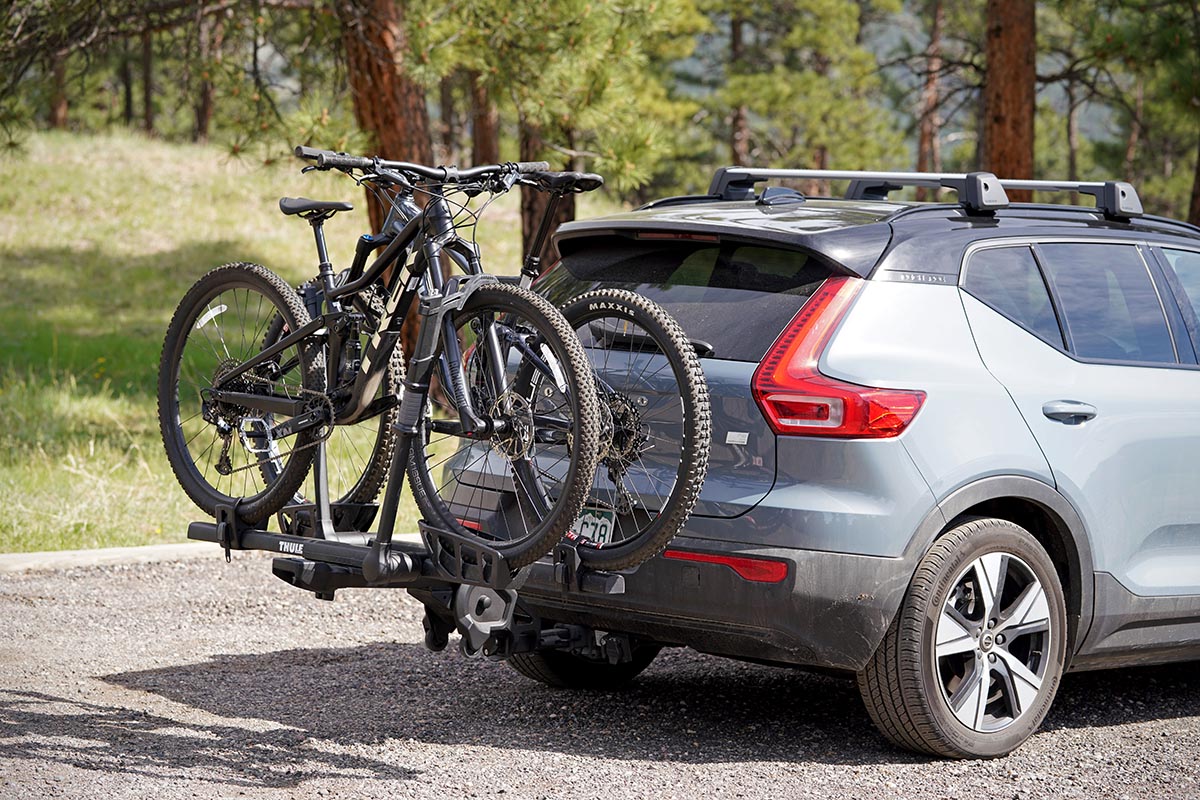
Fueled by the popularity of 1Up’s unique two-arm rack design, similarly built hitch racks have begun popping up all over the market in recent years. One of the better-designed options is Kuat’s Piston Pro. Like the 1Up, the design is almost all metal and features two arms that lift up to secure bikes. There are two main differences to keep in mind here. First, the Super Duty gets the edge in overall weight capacity at 100 pounds per bike, compared to the Piston Pro’s 60 to 67 pounds (weight capacity for the Piston Pro is determined by whether you have a 1.25- or 2-in. hitch receiver). Second is price: The Kuat will set you back an extra $198 compared to the double version of the 1Up Super Duty. To be fair, the Kuat does feature some nice included features that the 1Up lacks out of the box, most notably a semi-integrated bike lock.
A final option to consider is another offering from Kuat: their NV 2.0. At $898 for a two-bike version, the NV is priced almost identically to the Super Duty Double. The Kuat is 12 pounds lighter overall, but the 1Up can haul an additional 40 pounds per bike. That said, the Kuat does have some nice amenities, like an integrated cable lock, but for around the same price, we think the 1Up offers the better overall value. The Kuat’s plastic parts can be prone to failure over time, and the rugged durability of the 1Up is hard to beat. To learn more, check out our full review of the Kuat NV 2.0.
Back to the 1Up USA Super Duty Review See Our Hitch Bike Rack Guide